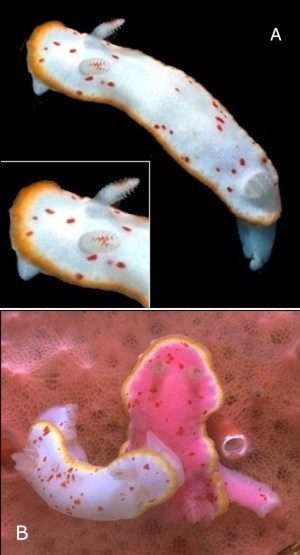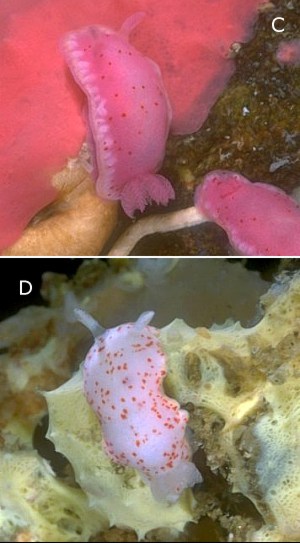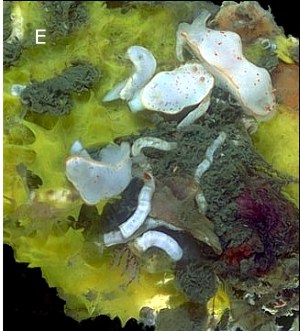
Noumea haliclona
New South Wales colour form
PHOTO
A. Green Point, Sydney Harbour, NSW, 6-9m, Feb. 1980, 10mm long. INSET: Note characteristic red mark on anterior edge of rhinophore club. B. Fisherman's Beach, Twofold Bay, southern NSW, intertidal, March 1986, 1 pink (18mm long), 7 white (4-17mm) on sponge (Darwinella gardineri). C. Juveniles, 2-7mm long, E side of Split Solitary Is., 21m, Coffs Harbour Region, northern NSW, December 1990. On Darwinella cf. australiensis. D. N side of Split Solitary Is., 15m, Coffs Harbour Region, northern NSW, March 1988. 13mm long on Darwinella? sp.. E. White Horse Point, Balmain, Sydney Harbour, NSW, June 1982, approx 10mm long, intertidal on yellow sponge (Aplysilla? sp.). PHOTOS: Bill Rudman.
In New South Wales animals range in colour from pink to white, usually with a yellow border to the mantle, but sometimes in juveniles the yellow border is absent. Green Cape forms a sharp geographic boundary between the NSW colour forms and the pink colour form found in Victoria, probably one of the few examples in the world of a political and biological boundary coinciding.
New South Wales specimens have been exhaustively studied (Avern, 1986) and the background colour is presumably genetically based because it is not the result of uptake of sponge pigment. The presence of direct development in this species and a pink colour form throughout its range, would suggest a southern origin, rather than a recent tropical origin, is more likely for this species. It is possible that the pink Victorian or pink or yellow Tasmanian form is ancestral. Colour in those forms matches exactly their food sponge and can be considered most probably to be cryptic. Similar pink and yellow colour states can be found in the sympatric Verconia verconis. Although the same, or similar, pink and yellow aplysillid sponges are found in NSW, it is of interest that in this region there appears a white colour state. This white state, with red spots and a yellow border is clearly no longer cryptic, and approximates well the predominant red-spotted colour group in this region.
See main Noumea haliclona page.
References:
• Rudman, W.B. (1983) The Chromodorididae (Opisthobranchia: Mollusca) of the Indo-West Pacific: Chromodoris splendida, C. aspersa and Hypselodoris placida colour groups. Zoological Journal of the Linnean Society, 78: 105-173.
• Rudman, W.B. (1986) The Chromodorididae (Opisthobranchia: Mollusca) of the Indo-West Pacific: Noumea flava colour group. Zoological Journal of the Linnean Society, 88: 377-404.
•Rudman, W.B. (1991) Purpose in Pattern: the evolution of colour in chromodorid nudibranchs. Journal of Molluscan Studies, 57, (T.E. Thompson Memorial Issue):5-21.
•Avern, G.J. (1986) The biology of the nudibranch mollusc Noumea haliclona (Burn, 1957). M.Sc. Thesis, University of Sydney (unpublished).


Rudman, W.B., 2000 (May 31) Noumea haliclona New South Wales colour form. [In] Sea Slug Forum. Australian Museum, Sydney. Available from http://www.seaslugforum.net/factsheet/noumhali4
Related messages
-
Noumea haliclona egg ribbon
From: David and Leanne Atkinson, January 19, 2009 -
Noumea haliclona & C. splendida feeding
From: L. & D. Atkinson, October 2, 2008 -
Noumea haliclona mating
From: Leanne & David Atkinson, September 23, 2005 -
Noumea haliclona from sthn Queensland
From: Gary Cobb, March 4, 2004 -
Noumea haliclona feeding in Nelson Bay
From: Dave Harasti, February 24, 2004 -
Noumea haliclona feeding
From: David & Leanne Atkinson, February 16, 2004 -
Noumea haliclona from Port Stephens
From: David & Leanne Atkinson, February 16, 2004
